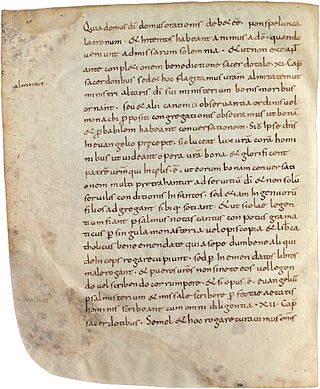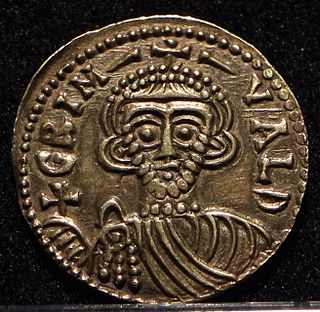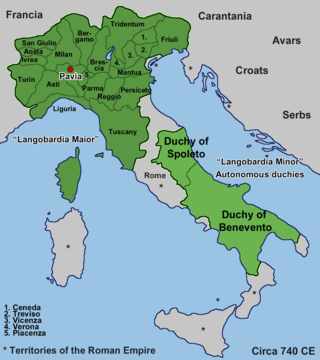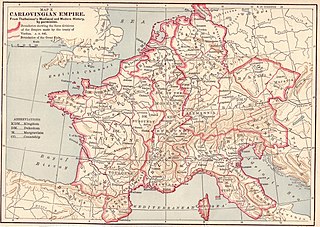Related Research Articles

Charlemagne was King of the Franks from 768, King of the Lombards from 774, and Emperor from 800, all until his death. Charlemagne succeeded in uniting the majority of Western and Central Europe, and he was the first recognized emperor to rule Western Europe after the fall of the Western Roman Empire approximately three centuries earlier. Charlemagne's rule saw a program of political and societal changes that had a lasting impact on Europe in the Middle Ages.
The 780s decade ran from January 1, 780, to December 31, 789.
The 770s decade ran from January 1, 770, to December 31, 779.

Year 789 (DCCLXXXIX) was a common year starting on Thursday of the Julian calendar. The denomination 789 for this year has been used since the early medieval period, when the Anno Domini calendar era became the prevalent method in Europe for naming years.

Desiderius, also known as Daufer or Dauferius, was king of the Lombards in northern Italy, ruling from 756 to 774. The Frankish king of renown, Charlemagne, married Desiderius's daughter and subsequently conquered his realm. Desiderius is remembered for this connection to Charlemagne and for being the last Lombard ruler to exercise regional kingship.

Constantine VI was Byzantine emperor from 780 to 797. The only child of Emperor Leo IV, Constantine was named co-emperor with him at the age of five in 776 and succeeded him as sole Emperor in 780, aged nine. His mother Irene exercised control over him as regent until 790, assisted by her chief minister Staurakios. The regency ended when Constantine reached maturity, but Irene sought to remain an active participant in the government. After a brief interval of sole rule Constantine named his mother empress in 792, making her his official colleague.

Aistulf was the Duke of Friuli from 744, King of the Lombards from 749, and Duke of Spoleto from 751. His reign was characterized by ruthless and ambitious efforts to conquer Roman territory to the extent that in the Liber Pontificalis, he is described as a "shameless" Lombard given to "pernicious savagery" and cruelty.

King of Italy was the title given to the ruler of the Kingdom of Italy after the fall of the Western Roman Empire. The first to take the title was Odoacer, a barbarian military leader, in the late 5th century, followed by the Ostrogothic kings up to the mid-6th century. With the Frankish conquest of Italy in the 8th century, the Carolingians assumed the title, which was maintained by subsequent Holy Roman Emperors throughout the Middle Ages. The last Emperor to claim the title was Charles V in the 16th century. During this period, the holders of the title were crowned with the Iron Crown of Lombardy.

The Duchy of Benevento was the southernmost Lombard duchy in the Italian Peninsula that was centred on Benevento, a city in Southern Italy. Lombard dukes ruled Benevento from 571 to 1077, when it was conquered by the Normans for four years before it was given to the Pope. Being cut off from the rest of the Lombard possessions by the papal Duchy of Rome, Benevento was practically independent from the start. Only during the reigns of Grimoald and the kings from Liutprand on was the duchy closely tied to the Kingdom of the Lombards. After the fall of the kingdom in 774, the duchy became the sole Lombard territory which continued to exist as a rump state, maintaining its de facto independence for nearly 300 years, although it was divided after 849. Benevento dwindled in size in the early 11th century, and was completely captured by the Norman Robert Guiscard in 1053.

Adalgis or Adelchis was an associate king of the Lombards from August 759, reigning with his father, Desiderius, until their deposition in June 774. He is also remembered today as the hero of the play Adelchi (1822) by Alessandro Manzoni.

Arechis II was a Duke of Benevento, in Southern Italy. He sought to expand the Beneventos' influence into areas of Italy that were still under Byzantine control, but he also had to defend against Charlemagne, who had conquered northern Italy.

Grimoald III was the Lombard Prince of Benevento from 788 until his own death. He was the second son of Arechis II and Adelperga. In 787, he and his elder brother Romoald were sent as hostages to Charlemagne who had descended the Italian peninsula as far as Salerno to receive the submission of Benevento. In return for peace, Arechis recognised Charlemagne's suzerainty and handed Grimoald over as a hostage.

The Duchy of Friuli was a Lombard duchy in present-day Friuli, the first to be established after the conquest of the Italian peninsula in 568. It was one of the largest domains in Langobardia Major and an important buffer between the Lombard kingdom and the Slavs, Avars, and the Byzantine Empire. The original chief city in the province was Roman Aquileia, but the Lombard capital of Friuli was Forum Julii, modern Cividale.
Hrodgaud or Rodgand was the Duke of Friuli from 774 to 776. In all likelihood he was already duke under Desiderius, notwithstanding some Frankish sources, such as the Einhardis annales, who say that Charlemagne put him in power after the Siege of Pavia.
Winigis, also spelled Winiges or Winichis, was the Duke of Spoleto from 789 to his death. He was sent by Charlemagne in 788 with Frankish troops to assist Dukes Hildeprand of Spoleto and Grimoald III of Benevento against a Byzantine invasion.

The March of Friuli was a Carolingian frontier march, established in 776 as the continuation of the Lombard Duchy of Friuli, established against the Slavs and Avars. It was ceded to the Duchy of Bavaria as the March of Verona in 952. Its territory comprised parts of modern-day Italy, Slovenia and Croatia.
Toto was the self-styled duke of Nepi, the leading magnate of Etruria, who staged a coup d'état in Rome in 767. He became Duke of Rome for a year until his death. The principal sources documenting his takeover are the vita of Pope Stephen III in the Liber Pontificalis and a surviving deposition of the primicerius Christopher from 769, preserved in a ninth-century manuscript of Verona, the Depositio Christophori.
Probatus was the Abbot of Farfa from 770 until 781, and the first abbot native to the Sabina. He steered the abbey through the fall of the Kingdom of the Lombards, trying to prevent the disastrous aggression of its last king, and kept it from falling under the jurisdiction of either the Papacy or the Papal States. With the benefit of his local connections he oversaw a great expansion of the abbey's properties through grants and purchases, and also rationalised its holdings to create a robust base for an early medieval monastic community.
Leo I was archbishop of Ravenna from A.D. 770, following a disputed election, until his death in A.D. 777. Archbishop Leo played an important role in the arrest of Paul Afiarta and was the subject of letters from Pope Hadrian I to Charlemagne collected in the Codex Carolinus and dated from late 774.
In late 788 or early 789, the Byzantine Empire invaded southern Italy in an effort to detach the kingdom of the Lombards from the Frankish domination and restore the exiled king Adelchis. The expeditionary army, support by the Sicilian theme, was defeated in a major battle by a combined force of Lombards and Franks under Duke Grimoald III of Benevento.
References
- ↑ Hodgkin, 31.
- ↑ Regnum Francorum Online